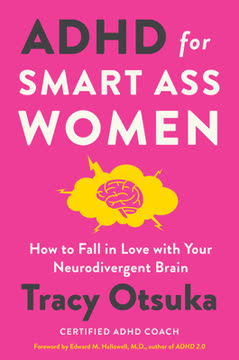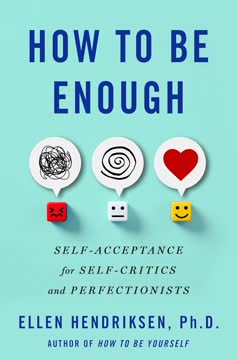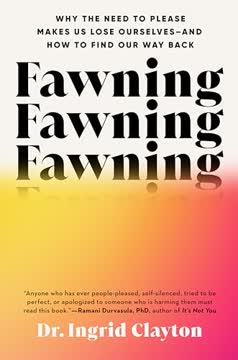Key Takeaways
1. Fawning is a Trauma Response, Not a Flaw.
Fawning isn’t conscious manipulation. Rather, it’s a way we seek safety in the face of exploitation, shame, neglect, abuse, or other harm.
Survival mechanism. Fawning, coined by psychotherapist Pete Walker, is a trauma response where an individual becomes appealing to a threat to defuse conflict and ensure safety. Unlike conscious manipulation or people-pleasing, fawning is an involuntary, instinctual survival mechanism, often developed in disempowering or abusive situations. It's a hybrid response, simultaneously activating hyperarousal (managing others' moods) and hypoarousal (detaching from self).
Connection as protection. For fawners, maintaining connection, even with an abuser, is perceived as the best chance for survival, especially when dependent on that person (e.g., a child on a caregiver, an employee on a boss). This strategy, while effective in neutralizing immediate danger, comes at the invisible cost of self-abandonment, where one's own needs, values, and opinions are surrendered. This reinforces vulnerability and can lead to a loss of self.
Beyond fight, flight, freeze. While fight, flight, and freeze are well-known trauma responses, fawning offers another option when these are unavailable or too dangerous. It's "playing LIFE" by appearing agreeable, ingratiating, or normal, even when terrified. This adaptive response, though lifesaving in the moment, can become a chronic pattern, leading individuals to believe they are perpetually "fine" or that their symptoms are personal failings rather than responses to complex trauma.
2. Power Structures and Early Experiences Fuel Fawning.
We can’t just say, Stop doing that! when we continue to live in contexts that encourage, and actually necessitate fawning.
Systemic reinforcement. Fawning is not an isolated individual problem but is deeply embedded and reinforced by various power structures and societal norms. These contexts implicitly and explicitly demand self-erasure and compliance, making fawning an adaptive, often rewarded, behavior. Examples include:
- Patriarchy: Traits historically labeled feminine (deferring, caretaking) are fawning behaviors.
- Cultural Norms: "Respect your elders" can enforce obedience over self-reliance.
- Family Systems: Dysfunctional families often require children to appease parents to maintain peace.
- Racism: Code-switching and performing "coolness" are fawning responses to systemic oppression.
Early life conditioning. Many fawners develop this response in childhood due to pervasive invalidation, neglect, or abuse. Children, dependent on caregivers, learn to prioritize external approval to secure vital attachment and safety. This can lead to hyper-independence, as interpersonal safety nets are perceived as unreliable, forcing individuals to figure things out alone and internalize blame.
Narcissism and toxic positivity. Living with narcissistic or emotionally immature individuals often necessitates fawning to navigate unpredictable environments. Additionally, societal pressures like "toxic positivity" and "spiritual bypassing" encourage suppressing negative emotions and "getting over" trauma, inadvertently reinforcing fawning by shaming authentic feelings and promoting denial. Gaslighting further erodes self-trust, making fawners question their own reality and internalize blame.
3. Fawning Manifests as Self-Minimization, Anxiety, and Shame.
When we minimize ourselves and our needs for weeks, for months, for years, we ultimately don’t recognize that we’re operating at a portion of our capacity.
Shrinking the self. Fawning often involves self-minimization, where individuals unconsciously reduce their needs, feelings, and physical presence to accommodate others. This proportional adaptation becomes a survival strategy, making one's existence feel less threatening to those in power. Justifications like "it's temporary," "it's for the best," or "when it's good, it's so good" are used to rationalize this shrinking, leading to a diminished sense of self-worth.
Constant vigilance and worry. Hypervigilance and anxiety are hallmarks of fawning, as individuals constantly scan their environment for potential threats or shifts in others' moods. This "walking on eggshells" leads to preoccupation with worst-case scenarios, overthinking, and difficulty sleeping. Fawners often mask their anxiety through overfunctioning, overcommitting, and perfectionism, believing that achievement and pleasing others will secure relational safety and validation.
The shame spiral. Fawning perpetuates a deep shame spiral. First, shame arises from the traumatic events themselves ("Something is wrong with me"). Second, the invalidating responses to these traumas deepen the shame ("There is something wrong with me"). Third, the fawning behaviors—hiding, shapeshifting, lying—are perceived as personal failings, reinforcing the belief "I am bad." This self-hatred becomes a heavy cost, poisoning self-perception and hindering authentic healing.
4. Trauma Bonds and Reenactment Perpetuate Fawning Cycles.
Adults, as well as children, may develop strong emotional ties with people who intermittently harass, beat, and threaten them. The persistence of these attachment bonds leads to confusion of pain and love.
Repeating the past. Trauma reenactment involves unconsciously repeating behaviors or relationship patterns from one's trauma history in current situations. This isn't about mastering the past but often leads to the same turmoil, as the brain gravitates towards what is familiar, interpreting chaos as "home." Fawning, as a deeply ingrained coping mechanism, becomes a default response, perpetuating cycles of mistreatment by habitually minimizing or blocking out harmful behaviors.
The "hurts so good" dynamic. Trauma bonding arises from intermittent reinforcement, where cycles of abuse or neglect are interspersed with periods of kindness or "saving." This creates a powerful hormonal attachment, leading survivors to confuse intense highs and lows with love. Tactics like gaslighting, future faking, love bombing, and hoovering are used by abusers to maintain this bond, making it incredibly difficult for fawners to recognize the abuse or leave the relationship.
Sex as currency. Sexual fawning is a pervasive manifestation, especially for women taught that sexuality is their primary form of power. It involves using sex as currency to please, appease, or shapeshift into a desired object, often at the expense of personal pleasure, consent, or self-esteem. This can lead to a distorted sense of intimacy, where physical acts are performed for security or attention rather than genuine connection, further disconnecting fawners from their bodies and desires.
5. Unfawning Begins with Internal Connection and Self-Trust.
We are the only ones who know how to heal ourselves.
Shifting the compass. Unfawning is a paradigm shift from external validation to internal guidance, building a new relationship with oneself based on trust and connection. It's about expanding one's vision beyond binary thinking (safe/unsafe, me/you) to embrace nuance, wholeness, and self-love. This journey is unique for each individual, starting with self-compassion rather than stripping away protective fawning behaviors.
Orienting to the present. A fundamental practice in unfawning is "orienting," a technique from Somatic Experiencing. This involves consciously engaging the senses—sight, sound, smell, touch—to connect with the present moment and environment. By slowing down and widening one's perspective, the nervous system signals safety, reducing dissociation and bringing individuals back to their center. This simple practice helps fawners move from autopilot to embodied awareness.
Resourcing inner wisdom. Unfawning involves discovering and utilizing internal and external "resources" that foster presence, connection, and safety. This isn't about cognitive lists but tuning into what the body genuinely needs right now. It could be:
- Engaging in expressive arts (painting, drawing, writing).
- Connecting with nature (walking, forest bathing).
- Listening to music or humming.
- Taking intentional alone time or physical space.
This process nurtures a deeper connection to self, allowing fawners to identify and follow their intuition, even if it feels counter to lifelong conditioning.
6. Heal Trauma Through Body-Based Reprocessing and Reparenting.
Trauma is trapped in the body. Our unexpressed feelings are stuck there, too. So this is body-focused work, stepping away from the desk and our phones, stepping out of autopilot.
Getting unstuck. Unfawning requires reprocessing unresolved trauma, which remains trapped in the body and perpetuates chronic fawning. This involves revisiting and working through traumatic events in a safe, embodied way, allowing feelings to be felt and integrated. Unlike purely cognitive approaches, trauma therapies focus on bottom-up, experiential work to release the body's stuck survival energy.
Reprocessing modalities:
- Internal Family Systems (IFS): Views the psyche as "parts" (e.g., the fawner, the good girl) that developed to protect. Healing involves separating from these parts, understanding their protective intent, and allowing the core "Self" to lead.
- Somatic Experiencing (SE): Focuses on physical sensations and completing the body's natural response to threat, allowing trapped energy to discharge and restore nervous system regulation.
- EMDR (Eye Movement Desensitization and Reprocessing): Uses bilateral stimulation (e.g., eye movements, tapping) to help the brain process and consolidate traumatic memories, reducing their emotional charge and replacing negative beliefs with positive ones.
Becoming your own caregiver. Reparenting is a crucial aspect of unfawning, where individuals become the nurturing, validating parent they lacked in childhood. This involves acknowledging unmet needs, challenging negative self-beliefs, and providing oneself with the care, rest, and emotional support that was missing. Inner child work, often visual or sensory, helps to connect with and free younger, wounded parts of the self, creating internal safety and allowing for emotional maturity.
7. Reclaim Your Voice: Embrace Healthy Anger, Assertiveness, and Boundaries.
We are meant to experience the full range of emotions, and anger is a valuable member of the team.
Igniting inner fire. Many fawners have suppressed their fight response, disconnecting from anger due to past invalidation or punishment. Unfawning requires awakening this dormant anger, not as destructive rage, but as a healthy, mobilizing force. Anger can be a guide, signaling unmet needs and providing the energy to assert oneself and set boundaries. Learning to feel and process anger, even through physical release like "big stomping" or art, allows for its healthy integration without harming oneself or others.
Finding your assertive voice. Assertiveness for fawners often feels aggressive or selfish due to past conditioning. However, it's about communicating needs and opinions clearly and respectfully, recognizing that one's own needs matter. This involves tolerating the discomfort of potential criticism or disagreement, understanding that expressing oneself doesn't guarantee a specific outcome but provides vital information for decision-making. It's a process of moving from passivity to activity, gradually mapping out new territory in the body.
Establishing personal limits. Boundaries are essential for fawners to reclaim their center. This means:
- Finding your "no": Stopping overextension, overfunctioning, and perpetually solving others' problems. It's about not being more responsible for others' lives than they are.
- Protecting your space: Deciding what you will and won't accommodate, building a "wall" of safety around yourself to prevent infringement.
Boundaries are not about controlling others but about self-care and accountability. They may lead to difficult conversations or even the end of relationships, but they are crucial for authentic connection and self-respect.
8. Cultivate Authentic Relationships and Practice Accountability.
The gift of unfawning is we can be ourselves!
Building trust in relationships. After a lifetime of fawning, fawners can be wary of relationships. Unfawning involves learning to trust oneself and others by gradually testing the waters of vulnerability. This means discerning safe people who offer mutual respect and reciprocity, rather than performing for approval. It's a process of recognizing that withholding isn't always avoiding, and that true vulnerability means sharing oneself authentically, even if it means not everyone will understand or approve.
Accountability and repair. Unfawning extends to taking accountability for past behaviors, even those born of trauma. This includes acknowledging where one's fawning (e.g., shrinking, caretaking, lying) may have inadvertently caused harm to others. The practice of "rupture and repair" is vital: when missteps or conflicts occur, returning to loved ones with apologies and reassurance reinforces connection, transforming negative experiences into stronger bonds.
Embracing authenticity. The culmination of unfawning is the discovery and embodiment of one's authentic self. This means shedding masks, embracing one's true nature, desires, and opinions, and taking up space without apology. It's about realizing that self-love is not a consolation prize but the foundation for genuine connection. As fawners stop compulsively abandoning themselves, they learn to welcome themselves fully to the party of life, grounded, real, and embodied.
Last updated:
Review Summary
Fawning explores the fourth trauma response alongside fight, flight, and freeze. Readers praise Clayton's insightful exploration of this overlooked behavior, combining clinical expertise with personal experiences. Many found the book validating and transformative, offering tools for healing and self-discovery. Reviewers appreciated the balance of technical information and relatable stories. Some noted repetition and organization issues, while others wanted more concrete strategies for addressing societal triggers. Overall, the book is highly recommended for those interested in trauma responses and personal growth.
Similar Books










Download PDF
Download EPUB
.epub digital book format is ideal for reading ebooks on phones, tablets, and e-readers.





